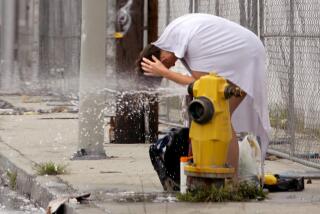Editorial: If the hepatitis A outbreak doesn’t convince you to wash your hands after using the toilet, nothing will
- Share via
It’s bad enough, just from a human dignity perspective, that there’s such a scarcity of working public toilets and hand-washing stations for the homeless. Now, there’s even more reason to get more facilities up and running.
The Los Angeles County Department of Public Health last week declared an outbreak of hepatitis A, citing 12 cases as of Monday. Only four are cases in which people acquired the disease locally, but that’s enough for officials to sound the alarm. And few populations are more vulnerable to acquiring it — and suffering more severe cases of it — than the homeless community. More than three-quarters of the cases identified here have been among homeless people.
This highly contagious liver disease is acquired when an uninfected person ingests food or water that has been contaminated with the feces of an infected person. Commonly, it is transmitted after an infected person goes to the bathroom, doesn’t thoroughly wash his or her hands with soap and water and then prepares or touches another person’s food.
This outbreak is in the early stages, so let’s work swiftly and urgently to stop it in its tracks lest it metastasize into the kind of crisis now facing San Diego County. Officials there had reported 461 cases, 315 hospitalizations and 17 deaths as of Tuesday. Hepatitis A usually isn’t fatal, but it can be debilitating or even lethal for people with compromised immune systems or other underlying medical conditions.
For the last several years, there have been no cases of hepatitis A among the homeless population in L.A. County.
There are usually about 40 to 60 cases of hepatitis A in Los Angeles County each year, but they are generally easy to track and quick to contain. For the last several years, there have been no cases of the disease among the homeless population. However, the existence of even a handful of cases among people who live closely together, often share food and utensils, and cannot easily track their contacts is a blueprint for a potentially massive outbreak.
The best and easiest way to tackle this disease is to vaccinate against it. The Department of Public Health has launched an aggressive vaccination program in shelters, community clinics, service provider centers and on the streets themselves. The department has embedded public health nurses, equipped with coolers of vaccines, among outreach workers who make contact with homeless people during the day on the streets and in encampments.
Persuading homeless people who are already distrustful of strangers to agree to be vaccinated, however, can be a tough sell. Sometimes a team will be out all day and only give 15 vaccinations, according to Barbara Ferrer, director of the L.A. County Department of Public Health.
In little more than a week the department has scrambled to vaccinate about 1,200 at-risk homeless people, drug users and their service providers. That’s a good start. But considering that L.A. County has more than 57,000 homeless people, the department’s nurses have got some work to do. They are also handing out hand sanitizers to homeless people and reaching out to private-sector partners that could help provide vaccinations.
Now, if only the city of Los Angeles could react with this same speed to the toilet shortage crisis.
True, it’s easier to vaccinate homeless people than it is to install a row of toilets and hand-washing stations for them and hire the necessary security. And the city has started to address the problem, albeit with little yet to show for it. Officials promised to have a city-run hygiene center including 10 toilets and hand-washing stations ready this month; it’s now scheduled to be up and running in a skid row parking lot by mid-October. Meanwhile, L.A. City Councilman Mike Bonin has asked city officials to identify funding for emergency portable restrooms with attendants and to explore creation of a mobile toilet program.
Bonin has also secured funding to keep the public restrooms at Ocean Front Walk in Venice Beach open 24 hours a day. Mystifyingly, however, the city’s Department of Recreation and Parks has yet to put the money to use. How about if the city does that — tomorrow? The toilets are needed anyway, and now we have an outbreak to stifle.
Follow the Opinion section on Twitter @latimesopinion or Facebook
More to Read
A cure for the common opinion
Get thought-provoking perspectives with our weekly newsletter.
You may occasionally receive promotional content from the Los Angeles Times.










